Page 414 of 569
413 Practical hints
What to do if …
Where will I find ...?
Unlocking / locking in an
emergency
Resetting activated head restraints
Replacing SmartKey batteries
Replacing bulbs
Replacing wiper blades
Flat tire
Bleeding the fuel system
(diesel engine only)
Battery
Jump starting
Towing the vehicle
Fuses
Page 423 of 569
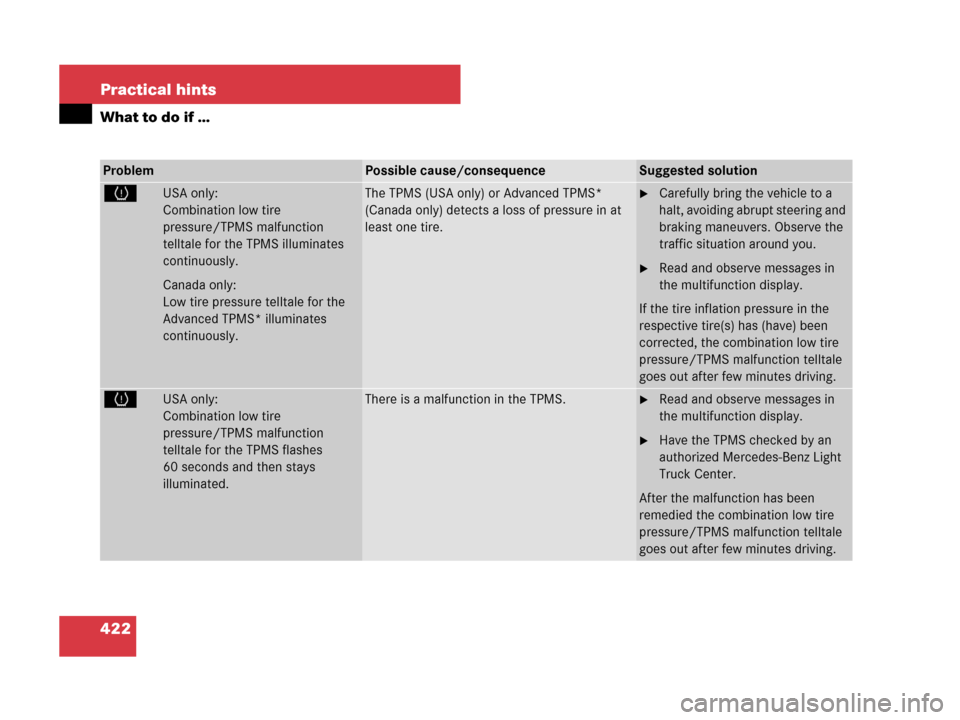
422 Practical hints
What to do if …
ProblemPossible cause/consequenceSuggested solution
HUSA only:
Combination low tire
pressure/TPMS malfunction
telltale for the TPMS illuminates
continuously.
Canada only:
Low tire pressure telltale for the
Advanced TPMS* illuminates
continuously.The TPMS (USA only) or Advanced TPMS*
(Canada only) detects a loss of pressure in at
least one tire.�Carefully bring the vehicle to a
halt, avoiding abrupt steering and
braking maneuvers. Observe the
traffic situation around you.
�Read and observe messages in
the multifunction display.
If the tire inflation pressure in the
respective tire(s) has (have) been
corrected, the combination low tire
pressure/TPMS malfunction telltale
goes out after few minutes driving.
HUSA only:
Combination low tire
pressure/TPMS malfunction
telltale for the TPMS flashes
60 seconds and then stays
illuminated.There is a malfunction in the TPMS.�Read and observe messages in
the multifunction display.
�Have the TPMS checked by an
authorized Mercedes-Benz Light
Truck Center.
After the malfunction has been
remedied the combination low tire
pressure/TPMS malfunction telltale
goes out after few minutes driving.
Page 424 of 569
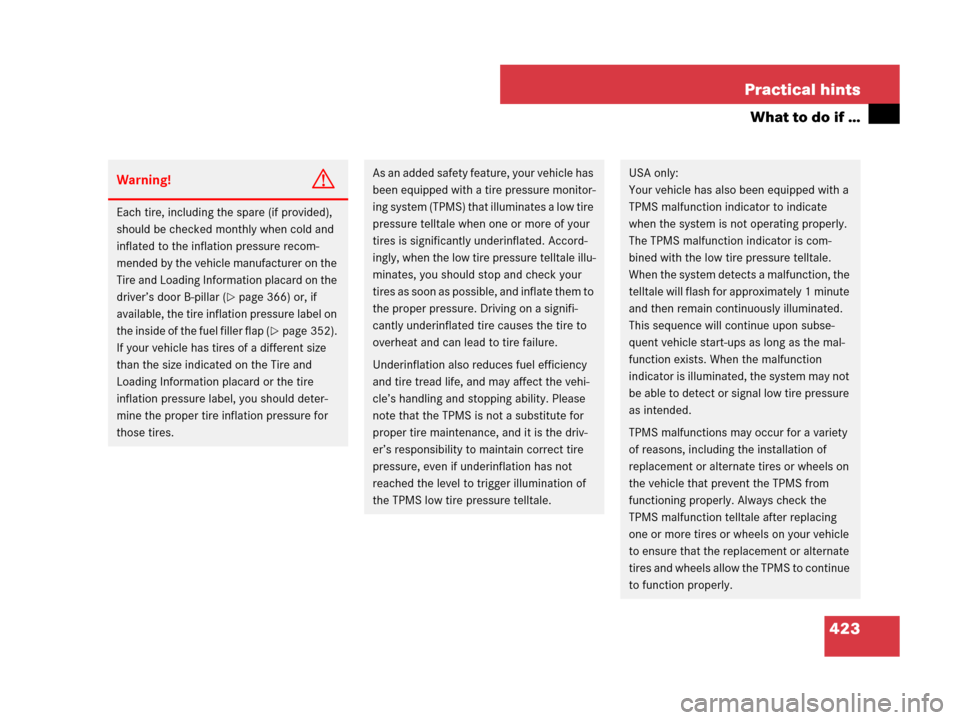
423 Practical hints
What to do if …
Warning!G
Each tire, including the spare (if provided),
should be checked monthly when cold and
inflated to the inflation pressure recom-
mended by the vehicle manufacturer on the
Tire and Loading Information placard on the
driver’s door B-pillar (
�page 366) or, if
available, the tire inflation pressure label on
the inside of the fuel filler flap (
�page 352).
If your vehicle has tires of a different size
than the size indicated on the Tire and
Loading Information placard or the tire
inflation pressure label, you should deter-
mine the proper tire inflation pressure for
those tires.
As an added safety feature, your vehicle has
been equipped with a tire pressure monitor-
ing system (TPMS) that illuminates a low tire
pressure telltale when one or more of your
tires is significantly underinflated. Accord-
ingly, when the low tire pressure telltale illu-
minates, you should stop and check your
tires as soon as possible, and inflate them to
the proper pressure. Driving on a signifi-
cantly underinflated tire causes the tire to
overheat and can lead to tire failure.
Underinflation also reduces fuel efficiency
and tire tread life, and may affect the vehi-
cle’s handling and stopping ability. Please
note that the TPMS is not a substitute for
proper tire maintenance, and it is the driv-
er’s responsibility to maintain correct tire
pressure, even if underinflation has not
reached the level to trigger illumination of
the TPMS low tire pressure telltale.USA only:
Your vehicle has also been equipped with a
TPMS malfunction indicator to indicate
when the system is not operating properly.
The TPMS malfunction indicator is com-
bined with the low tire pressure telltale.
When the system detects a malfunction, the
telltale will flash for approximately 1 minute
and then remain continuously illuminated.
This sequence will continue upon subse-
quent vehicle start-ups as long as the mal-
function exists. When the malfunction
indicator is illuminated, the system may not
be able to detect or signal low tire pressure
as intended.
TPMS malfunctions may occur for a variety
of reasons, including the installation of
replacement or alternate tires or wheels on
the vehicle that prevent the TPMS from
functioning properly. Always check the
TPMS malfunction telltale after replacing
one or more tires or wheels on your vehicle
to ensure that the replacement or alternate
tires and wheels allow the TPMS to continue
to function properly.
Page 443 of 569
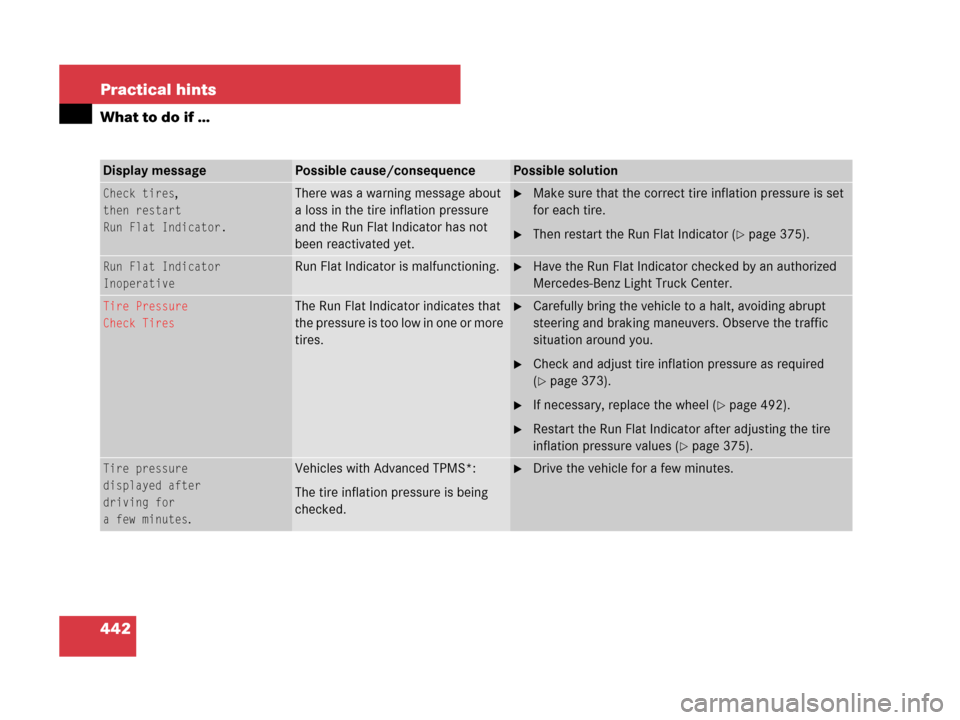
442 Practical hints
What to do if …
Display messagePossible cause/consequencePossible solution
Check tires,
then restart
Run Flat Indicator.
There was a warning message about
a loss in the tire inflation pressure
and the Run Flat Indicator has not
been reactivated yet.�Make sure that the correct tire inflation pressure is set
for each tire.
�Then restart the Run Flat Indicator (�page 375).
Run Flat Indicator
InoperativeRun Flat Indicator is malfunctioning.�Have the Run Flat Indicator checked by an authorized
Mercedes-Benz Light Truck Center.
Tire Pressure
Check TiresThe Run Flat Indicator indicates that
the pressure is too low in one or more
tires.�Carefully bring the vehicle to a halt, avoiding abrupt
steering and braking maneuvers. Observe the traffic
situation around you.
�Check and adjust tire inflation pressure as required
(
�page 373).
�If necessary, replace the wheel (�page 492).
�Restart the Run Flat Indicator after adjusting the tire
inflation pressure values (
�page 375).
Tire pressure
displayed after
driving for
a few minutes
.
Vehicles with Advanced TPMS*:
The tire inflation pressure is being
checked.�Drive the vehicle for a few minutes.
Page 444 of 569

443 Practical hints
What to do if …
Display messagePossible cause/consequencePossible solution
Tire Pressure Monitor
InoperativeThe TPMS or Advanced TPMS* is
malfunctioning.�Have the TPMS or Advanced TPMS* checked by an
authorized Mercedes-Benz Light Truck Center.
Tire Pressure Monitor
Inoperative
No Wheel SensorsThere are wheels without appropriate wheel
sensors mounted (e.g. winter tires).�Have the TPMS or Advanced TPMS* checked by an
authorized Mercedes-Benz Light Truck Center.
�Have the wheel sensors installed by an authorized
Mercedes-Benz Light Truck Center.
Tire Pressure Monitor
Wheel Sensor MissingVehicles with Advanced TPMS*:
One or more sensors are defect (e.g.
battery is empty).
The respective tire is indicated by
---
instead of the tire inflation pressure in the
multifunction display.
�Have the Advanced TPMS* checked by an autho-
rized Mercedes-Benz Light Truck Center.
Vehicles with Advanced TPMS*:
One or more wheels without appropriate
wheel sensors mounted (e.g. spare tire).
The respective tire is indicated by
---
instead of the tire inflation pressure in the
multifunction display.
�Have the wheel sensors installed by an authorized
Mercedes-Benz Light Truck Center.
Tire Pressure Monitor
Currently UnavailableThe TPMS or Advanced TPMS* is unable to
monitor the tire pressure due to a nearby
radio interference source.�As soon as the causes of the malfunction have been
removed, the TPMS or Advanced TPMS* automati-
cally becomes active again after a few minutes
driving.
Page 463 of 569
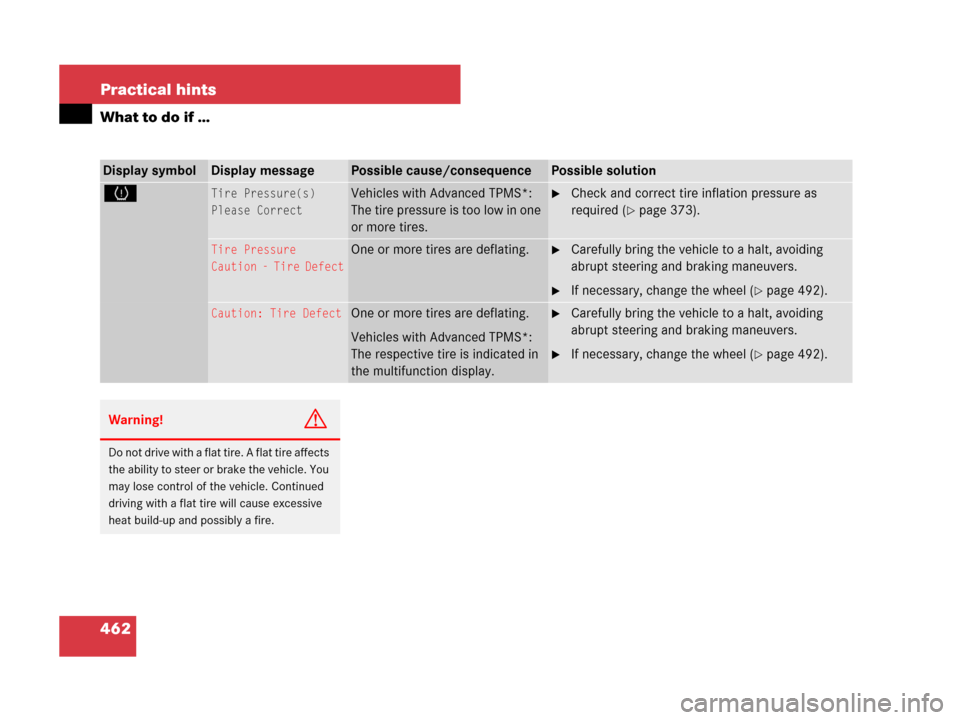
462 Practical hints
What to do if …
Display symbolDisplay messagePossible cause/consequencePossible solution
HTire Pressure(s)
Please CorrectVehicles with Advanced TPMS*:
The tire pressure is too low in one
or more tires.�Check and correct tire inflation pressure as
required (
�page 373).
Tire Pressure
Caution - Tire DefectOne or more tires are deflating.�Carefully bring the vehicle to a halt, avoiding
abrupt steering and braking maneuvers.
�If necessary, change the wheel (�page 492).
Caution: Tire DefectOne or more tires are deflating.
Vehicles with Advanced TPMS*:
The respective tire is indicated in
the multifunction display.�Carefully bring the vehicle to a halt, avoiding
abrupt steering and braking maneuvers.
�If necessary, change the wheel (�page 492).
Warning!G
Do not drive with a flat tire. A flat tire affects
the ability to steer or brake the vehicle. You
may lose control of the vehicle. Continued
driving with a flat tire will cause excessive
heat build-up and possibly a fire.
Page 464 of 569
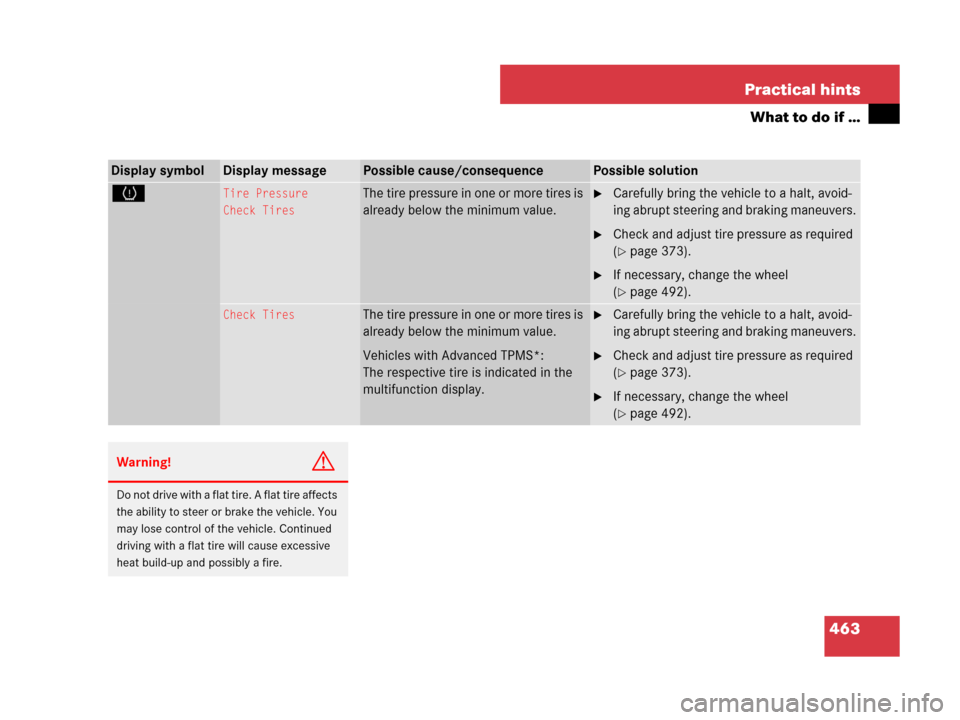
463 Practical hints
What to do if …
Display symbolDisplay messagePossible cause/consequencePossible solution
HTire Pressure
Check TiresThe tire pressure in one or more tires is
already below the minimum value.�Carefully bring the vehicle to a halt, avoid-
ing abrupt steering and braking maneuvers.
�Check and adjust tire pressure as required
(
�page 373).
�If necessary, change the wheel
(
�page 492).
Check TiresThe tire pressure in one or more tires is
already below the minimum value.
Vehicles with Advanced TPMS*:
The respective tire is indicated in the
multifunction display.�Carefully bring the vehicle to a halt, avoid-
ing abrupt steering and braking maneuvers.
�Check and adjust tire pressure as required
(
�page 373).
�If necessary, change the wheel
(
�page 492).
Warning!G
Do not drive with a flat tire. A flat tire affects
the ability to steer or brake the vehicle. You
may lose control of the vehicle. Continued
driving with a flat tire will cause excessive
heat build-up and possibly a fire.
Page 472 of 569
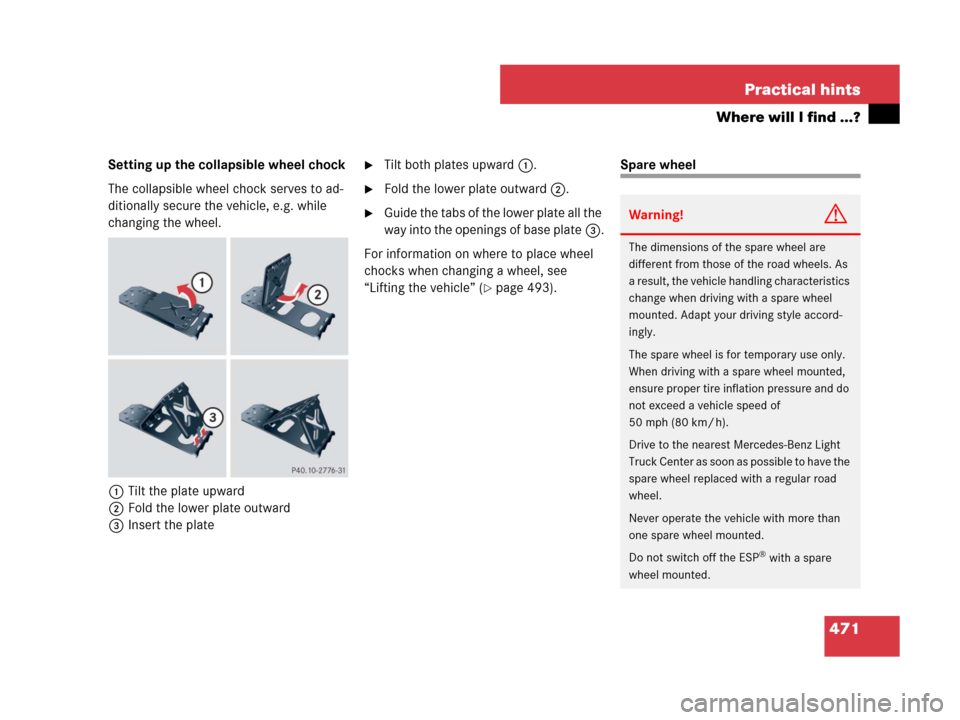
471 Practical hints
Where will I find ...?
Setting up the collapsible wheel chock
The collapsible wheel chock serves to ad-
ditionally secure the vehicle, e.g. while
changing the wheel.
1Tilt the plate upward
2Fold the lower plate outward
3Insert the plate�Tilt both plates upward1.
�Fold the lower plate outward2.
�Guide the tabs of the lower plate all the
way into the openings of base plate3.
For information on where to place wheel
chocks when changing a wheel, see
“Lifting the vehicle” (
�page 493).
Spare wheel
Warning!G
The dimensions of the spare wheel are
different from those of the road wheels. As
a result, the vehicle handling characteristics
change when driving with a spare wheel
mounted. Adapt your driving style accord-
ingly.
The spare wheel is for temporary use only.
When driving with a spare wheel mounted,
ensure proper tire inflation pressure and do
not exceed a vehicle speed of
50 mph (80 km/ h).
Drive to the nearest Mercedes-Benz Light
Truck Center as soon as possible to have the
spare wheel replaced with a regular road
wheel.
Never operate the vehicle with more than
one spare wheel mounted.
Do not switch off the ESP
® with a spare
wheel mounted.